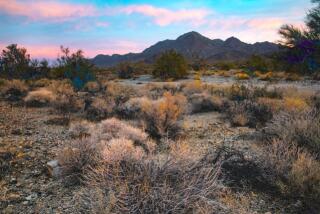A Homecoming of Sorts for Malibu’s 1st Residents
- Share via
With first light bleeding into the sky, a Chumash village was reborn Wednesday on a wind-swept plateau overlooking the ocean in Malibu.
There, tribal leaders and supporters gathered for a sunrise ceremony to kick off the creation of a demonstration village and interpretive center that will take root over the next year on an 8,000-year-old Chumash site along Pacific Coast Highway near Nicholas Canyon County Beach.
On four acres tucked among multimillion-dollar homes, a Chumash medicine woman burned sage, sounded a conch and offered a blessing on behalf of an emerging village of Chumash homes and native plant gardens that will be re-created to teach students and the public about the values and traditions of the ancient culture.
“This is a special area and a learning center for all people, not just Native American people,” said Charlie Cooke, a hereditary Chumash chief who helped create a similar teaching center in Ventura County. “This is all Chumash land and we’ve never given up on this land.”
The project is headed by the Ventura-based Wishtoyo Foundation, an environmental watchdog and educational group. The nonprofit has partnered with the Los Angeles County Department of Beaches and Harbors to create a master plan for the site that includes restoration of Nicholas Canyon Creek.
The county department owns the land and charges Wishtoyo $100 a year to occupy it. Chumash leaders say eight Native American prehistoric archeological sites have been documented within half a mile of the property.
A ceremonial circle and sweat lodge have been built and work began this summer to remove invasive plants from the creek bed and replace them with native species.
Wishtoyo Executive Director Mati Waiya, a member of the Santa Clara River Valley Chumash Turtle Clan, said several groups, including the Santa Monica-based Environment Now Foundation, funded the initial work.
Waiya said he hopes to raise about $350,000 from state, federal and nonprofit sources to complete the project, which is intended to serve as an open-air museum with a dozen traditional Chumash dwellings, ancestral tools and plank canoes.
Access to the site will be free, Waiya said. He said he wants to encourage Chumash people to take part in building the village and participate in programs and presentations to help bring it to life, offering visitors a sense of Chumash culture as it thrived thousands of years ago.
Waiya said he also would like to establish a string of demonstration villages along California’s coast. Ventura County has two Chumash interpretive centers, in Newbury Park and Thousand Oaks.
“This is a window into our culture,” Waiya said. “It is the awakening of a village that is long overdue.”
The village awoke Wednesday to four deep blasts from a conch shell, as about three dozen Chumash and other project supporters gathered around a ceremonial fire.
Chumash medicine woman A-lul-koy Lotah, a Ventura resident raised in Malibu, offered a blessing to the land and led a singsong chant that rose above a biting wind.
“We want good things to come from this land,” Lotah explained to the gathering. “It’s our earth, our mother. It’s the only mother who will stand by you the rest of your life.”
One by one, participants made individual offerings. They doused themselves with the sweet-smelling smoke of smoldering sage and took turns sprinkling tobacco into the fire, giving thanks that after about five years of planning, the project was coming to fruition.
“I see in my mind the generations of students who will be brought to this place and will learn the deep caring and value the Chumash people bring to this land,” said Carole Goldberg, a UCLA law professor who serves on Wishtoyo’s board of directors.
Nearby, red flags marked the spots where the Chumash dwellings are to be built. Stacks of reeds and wood dried in the sun, remnants of the restoration work taking place on the creek. Actor Beau Bridges, who also is on Wishtoyo’s board, said he saw the project as part of the group’s larger mission to protect the environment.
More to Read
Sign up for Essential California
The most important California stories and recommendations in your inbox every morning.
You may occasionally receive promotional content from the Los Angeles Times.










